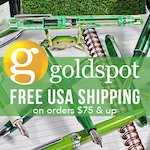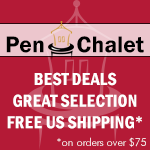(Susan M. Pigott is a fountain pen collector, pen and paperholic, photographer, and professor. You can find more from Susan on her blog Scribalishess.)
I was beyond excited when I first heard that Aurora was coming out with a flexible nib. I pre-ordered the blue 88 with flex nib as soon as I could. But then I started hearing some ambivalent feedback from pen shows, and my excitement waned. Fortunately, Kenro sent Pen Addict a test pen so I could try out the flex nib for myself.
First, a disclaimer: I am not an experienced flex nib user. I own two Omas pens with extra flessibile nibs and a few vintage pens with semi-flex nibs. I was not willing to push the Aurora test pen too hard (I have to return it, after all). So, keep this in mind as you read my review and look at the photos. It’s possible that users with more experience might get more flex out of the Aurora than I did.
This Aurora 88 70th Anniversary fountain pen is a gorgeous bright orange (a color that will be released later this year). It’s a typical Aurora 88 style, cigar-shaped, with the signature Aurora clip. The pen has a small ink window and is a piston filler.
Of course, what everyone wants to know is, “How is the flex nib?” Well . . .
The nib is solid 14k gold with super long tines. The test nib doesn’t have the usual Aurora scrollwork, but the photos I’ve seen of actual pens for sale show scrollwork on the nibs. The nib tip looks like a fine, though the size isn’t indicated anywhere on the nib itself.
I’ll be perfectly honest. When I inked up the test unit and started writing, I was immediately disappointed. The nib felt pretty stiff like a regular Aurora nib. And while I could get some line variation when I flexed the nib, it was slight.
I worked with the pen for several days, switched out the ink, practiced swirls hoping maybe the nib would loosen up a little, but the flex was still minimal.
I inked my Omas Ogiva Extra Flessibile fine with the same ink, Iroshizuku Tsuki-yo, to compare with the Aurora. What a difference. The Omas nib is springy and exhibits a great deal of flex without much effort. While neither pen flexes as much as a super-flex vintage nib, the Omas beat the Aurora hands down.
The examples below show how the two nibs compare:
Alphabet
Aurora
Omas
Swirls
Aurora
Omas
Sentence
Aurora top, Omas bottom
I canceled my preorder after working with the Aurora. I really wanted to love the pen and the nib, I just wasn’t impressed. While it has some flex, it offers nowhere near the flex that the Omas extra flessibile does. At first I thought maybe I was being unfair comparing the Aurora to the Omas extra flessibile. But then I saw some websites advertising the Aurora as a “super flexible” nib. I think that, if people claim that the nib is super flexible, it should at least be as flexible as the Omas. Unfortunately, it’s not.
Does the nib flex? Yes. Does it flex as much as an Omas Extra flessibile nib? No. Does it flex as much as a vintage superflex nib? Definitely not.
And yet . . . after writing with the nib daily for a week, I have to say that, in spite of the fact that the nib does not flex as much as I’d hoped, it’s a wonderful writer. The long tines offer a different feel from a standard nib, and you can write without flex quite easily.
But here’s the deal. The Aurora 88 70th Anniversary LE fountain pen with a flex nib costs $650. These pens are made of resin. Yes, they are limited, numbered editions (only 188 of each color). Yes, they have special, long-tined, semi-flex nibs. Yes, they write beautifully. But $650 is a pretty steep price for a resin pen with a semi-flex nib. If these were auroloide pens with flex nibs, I wouldn’t hesitate to get one.
Vanness Pens will be stocking the Aurora 88 70th Anniversary Flex Nib Fountain Pen but you have to act fast. The first release in Blue is already sold out. Send them a message to inquire about future releases.
Pros
- The Aurora 88 fountain pen is a terrific cigar-style pen. It’s a good size and weight for most users.
- The flex nib is beautiful and has gorgeous long tines reminiscent of some vintage Aurora fountain pens.
- The nib offers some flex and line variation, and when you write with it normally, it is smooth and the long tines provide a unique writing experience.
- The anniversary pens will be released over the year in a variety of colors to suit many tastes.
Cons
- The flex nib is certainly not a “superflex” nib. It isn’t even as flexible as an Omas extra flessibile. I would call it a semi-flex nib at best.
- The anniversary pens are made of resin not auroloide, and, in my view, they are overpriced. If they were in the $350-$400 range I’d feel better about purchasing one.
(Kenro Industries provided this product at no charge to The Pen Addict for review purposes.)
Enjoy reading The Pen Addict? Then consider becoming a member to receive additional weekly content, giveaways, and discounts in The Pen Addict shop. Plus, you support me and the site directly, which I am very grateful for.
Membership starts at just $5/month, with a discounted annual option available. To find out more about membership click here and join us!


































